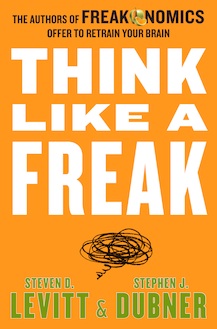By Jay M. Pasachoff
A few years ago, economists Steven Levitt and Stephen Dubner enthralled readers with first Freakonomics and then Superfreakonomics, in which they applied economic reasoning and scientific testing to a variety of practical situations. Their results were often counterintuitive. In their new book, they ask readers to use the same skills that they discussed in their earlier books; in other words, they asked their readers to think like the “Freaks” who used those economic and other reasoning skills.
The new book, written in an engaging and casual tone, gives many examples of particular situations. Though some of the examples are given as asides, 40 pages of notes just before the index at the end of the book provide references and explanations. For example, as you read (pg. 11) “you meet a lovely, conscientious couple with three children, and find yourself blurting out that child car seats are a waste of time and money (at least that’s what the crash-test data say,” you can look at note 11 (pg. 217) to find an article from 2010 from the journal Economic Inquiry and an article from 2005 from The New York Times Magazine, with the book’s authors as coauthors, with backup. “You’ll have to grow accustomed to people…sputtering with indignation,” at times, they explain.
Levitt and Dubner discuss hidden biases, such as people’s tendencies to choose “yes” or “no” instead of “I don’t know.” The famous story of a young Australian doctor and his mentor discovering that ulcers were caused by H. Pylori instead of by stress or fiery snacks, disregarding the conventional wisdom, led millions to benefit from the previously unsuspected antibiotic treatment (and led the two doctors to share in a Nobel Prize).
Levitt and Dubner show that “thinking like a Freak” is not “just code for ‘thinking like a child,'” but suggest that openness to new ideas in a childish way, “channeling your inner child can really pay off.” They show that small-bore solutions, in a sample region of China, like handing out cheap reading glasses instead of tackling education from the top down has raised reading scores. But sometimes, more recent evidence shows that Levitt was not always right; The New York Times on the day I am writing this (February 1, 2015) shows an education innovation in teaching math works better than Levitt and colleagues were quoted as thinking would be possible.
They discuss “conventional wisdom,” and that it is not always correct. Even the important health-related point that, contrary to popular assumptions, eating fat is probably good for you (the subject of my recent reviews of books by Nina Teicholz and by the Ottobonis) is mentioned.
The authors quote Albert Einstein as saying that “everything should be made as simple as possible, but not simpler.” Levitt and Dubner have written a book that makes you think, and that may lead you to some new ideas that will help your life or the lives of others. They describe how offering to properly chill the beer if notified of a visit in advance helped the Jewish paramilitary group Haganah avoid secret inspection by British officers. Their discussion of safety trade-offs with driverless cars may change your thinking of a contemporary topic under consideration.
The example of choosing the right way to aim for a key championship goal, in their book framed in terms of soccer, turned out to be applicable to the ending of the 2015 Superbowl, in which the Seattle Seahawks chose the nonobvious play near their goal, and paid for it with the game when a New England Patriots’ player intercepted the pass. The New York Times‘s “Upshot” column for February 2, by Justin Wolfers, agreed with the Freakonomics analysis—that the powerful offensive player might owe some of his fearsome record to the other team’s worry that the offense might pass instead of running, even only a yard from the goal line.
I am glad to recommend this book to all readers.
Astronomer and author Jay Pasachoff is the director of Hopkins Observatory and Field Memorial Professor of Astronomy at Williams College.




